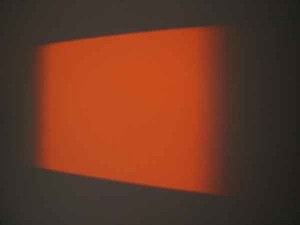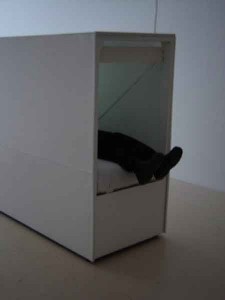When asked to write about Audio/Visual (A/V) production, I am faced with a dilemma of definition. For me, as for W. J. T. Mitchell, there is no such thing as purely visual media, as I believe that all media comes with the other senses, especially sound (media without sound in fact draws our attention back to sound through the very lack of it).
In the past, sound culture has been overlooked in favour for visual culture; generally through the myth that we live in a visual culture. Recently this myth has been further supported and even directed by galleries and the current heightened interest in video art. It is not uncommon to see video art in commercial galleries with the sound turned well down or even off. Why would an art buyer want sound being played through their dedicated flat screen video art monitor in their living room? Artists, then, can expect their sound will often be played at low volume or through substandard sound systems. Often in larger galleries, video work has numerous sound bleed issues, at times making it very hard to hear the work you are viewing (due to loud(er) work in the next space). These factors have lead to a silencing of video art, making true A/V works that present an equal sound to visual ratio rare.
The problems of perception and sound in video works are being addressed by a group of artists working in Sydney who have approached video directly through sound rather than vision. The group includes Sam Bruce, Andrew Gadow, Jon Hunter, Ivan Lisyak, Peter Newman and Alex White. Their works contain high levels of sound production that visually and aurally displays an abstract aesthetic. These artists, all graduates from the University of Western Sydney (mostly from the now closed Bachelor of Electronic Arts) have been greatly influenced by the video practice of David Haines and Joyce Hinterding. In addition all of these artists maintain a live sound practice and have all been involved in the audio events of impermanent.audio (an experimental sound evening I produced once a month between 2000-2006).
Two artists who produce work at the extremes of the practice are Ivan Lisyak and Peter Newman. Lisyak’s work Dying Everyday displays a highly concentrated approach to sound and vision. A singular tone plays for the duration, becoming noisier as the piece proceeds towards 20 mins. Like the simplicity tone, the visual world, a rectangular orange box with fuzzy sides, changes only slightly (one can only easily notice this change when the work is moving in fast forward). The effect of the minimal audio and visual is one of hallucination through lack of sensory input. The work is at the opposite end of the spectrum to that produced by Newman, who includes multiple layers of sound samples and images to create a dramatic psychedelic experience. These effects, produced through total saturation of audio and visual output, make the heart race and head swim.
The approach of the above producers differ from other A/V practitioners working in Sydney; namely Ryszard Dabek, Adam Costenoble, Brent Grayburn, Daniel Green and Virginia Hylard, who retain a strong sense of reality in both the sound and visual fields. Sound plays a central and unmissable role within these works. This is made most palpable in Costenoble’s work, The Chamber that requires a single viewer to venture into a wooden box. Once inside the viewer lies on their back and watches a dirt bike race around an abandoned landscape. Their body is literally vibrated by a large sub speaker placed under the box and the work affects the body in its displaced position.
All of the artists listed above exhibited at Pelt gallery, a gallery space that was primarily focused on sound; everything shown or performed in the space addressed sound as an element of the work. The establishment of the space was partially in answer to a problem with how gallery spaces in Sydney handle sound. Between late 2005 and late 2006 two weekly exhibitions and numerous sound performances were held, including the final year of impermannet.audio. With Pelt falling through the cracks of the defunct New Media Arts Board, and faced numerous noise complaints, there are again few outlets for the promotion of sound related practices. Put simply, the work of the artists above suffers through poor sound reproduction; a great projection is never enough.
Read More
The web archive of Pelt and impermanent.audio can be accessed at http://impermanent.info
 This work is licensed under a Creative Commons Attribution-NonCommercial-ShareAlike 2.5 Australia.
This work is licensed under a Creative Commons Attribution-NonCommercial-ShareAlike 2.5 Australia.








